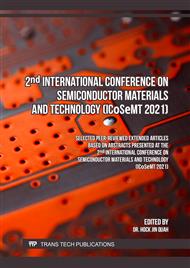[1]
F. Chen, X. Ji, S.P. Lau, Recent progress in group III-nitride nanostructures: from materials to applications, Materials Science and Engineering: R: Reports. 142 (2020) 100578.
DOI: 10.1016/j.mser.2020.100578
Google Scholar
[2]
C.A.M. Fabien, W.A. Doolittle, Guidelines and limitations for the design of high-efficiency InGaN single-junction solar cells, Solar Energy Materials and Solar Cells. 130 (2014) 354–363.
DOI: 10.1016/j.solmat.2014.07.018
Google Scholar
[3]
L. Sang, M. Liao, N. Ikeda, Y. Koide, M. Sumiya, Enhanced performance of InGaN solar cell by using a super-thin AlN interlayer, Applied Physics Letters. 99 (2011) 161109.
DOI: 10.1063/1.3654155
Google Scholar
[4]
J. Wu, W. Walukiewicz, K.M. Yu, W. Shan, J.W. Ager, E.E. Haller, H. Lu, W.J. Schaff, W.K. Metzger, S. Kurtz, Superior radiation resistance of In1−xGaxN alloys: Full-solar-spectrum photovoltaic material system, Journal of Applied Physics. 94 (2003) 6477–6482.
DOI: 10.1063/1.1618353
Google Scholar
[5]
B. Chouchen, M.H. Gazzah, A. Bajahzar, H. Belmabrouk, Numerical modeling of InGaN/GaN p-i-n solar cells under temperature and hydrostatic pressure effects, AIP Advances. 9 (2019) 045313.
DOI: 10.1063/1.5092236
Google Scholar
[6]
D. Pal, S. Das, Numerical simulation of GaN/InGaN p-i-n solar cells: Role of interlayers in promoting photovoltaic response, Optik. 221 (2020) 165403.
DOI: 10.1016/j.ijleo.2020.165403
Google Scholar
[7]
J. Mickevičius, D. Dobrovolskas, T. Steponavičius, T. Malinauskas, M. Kolenda, A. Kadys, G. Tamulaitis, Engineering of InN epilayers by repeated deposition of ultrathin layers in pulsed MOCVD growth, Applied Surface Science. 427 (2018) 1027–1032.
DOI: 10.1016/j.apsusc.2017.09.074
Google Scholar
[8]
A.G. Bhuiyan, K. Sugita, A. Hashimoto, A. Yamamoto, InGaN Solar Cells: Present State of the Art and Important Challenges, IEEE Journal of Photovoltaics. 2 (2012) 276–293.
DOI: 10.1109/JPHOTOV.2012.2193384
Google Scholar
[9]
P.C. Chang, C.L. Yu, Y.W. Jahn, S.J. Chang, K.H. Lee, Effect of growth temperature on the indium incorporation in ingan epitaxial films, Advanced Materials Research. 287–290 (2011) 1456–1459.
DOI: 10.4028/www.scientific.net/AMR.287-290.1456
Google Scholar
[10]
J. Song, S. P. Chang, C. Zhang, T. C. Hsu, J. Han, Significantly improved luminescence properties of nitrogen-polar (0001̅) InGaN multiple quantum wells grown by pulsed metalorganic chemical vapor deposition., ACS Applied Materials & Interfaces. 7 (2015) 273–278.
DOI: 10.1021/am506162z
Google Scholar
[11]
Y. Guo, X.L. Liu, H.P. Song, A.L. Yang, X.Q. Xu, G.L. Zheng, H.Y. Wei, S.Y. Yang, Q.S. Zhu, Z.G. Wang, A study of indium incorporation in In-rich InGaN grown by MOVPE, Applied Surface Science. 256 (2010) 3352–3356.
DOI: 10.1016/j.apsusc.2009.11.081
Google Scholar
[12]
V. Suresh Kumar, S.Y. Ji, Y.T. Zhang, K. Shojiki, J.H. Choi, T. Kimura, T. Hanada, R. Katayama, T. Matsuoka, Dependence of the V/III Ratio on Indium Incorporation in InGaN Films Grown by Metalorganic Vapour Phase Epitaxy, Journal of Nanoscience and Nanotechnology. 20 (2020) 2979–2986.
DOI: 10.1166/jnn.2020.17466
Google Scholar
[13]
M.R. Islam, M.R. Kaysir, M.J. Islam, A. Hashimoto, A. Yamamoto, MOVPE growth of InxGa1−xN (x ∼ 0.4) and fabrication of homo-junction solar cells, Journal of Materials Science & Technology. 29 (2013) 128–136.
DOI: 10.1016/j.jmst.2012.12.005
Google Scholar
[14]
A.S. Yusof, Z. Hassan, S.. Ng, M.A. Ahmad, M.A.A.Z. Md Sahar, S.O.S. Hamady, C. Chevallier, The dependence of indium incorporation on specified temperatures in growing InGaN/GaN heterostructure using MOCVD technique, Materials Research Bulletin. 137 (2021) 111176.
DOI: 10.1016/j.materresbull.2020.111176
Google Scholar
[15]
D.V.P. McLaughlin, J.M. Pearce, Progress in indium gallium nitride materials for solar photovoltaic energy conversion, Metallurgical and Materials Transactions A: Physical Metallurgy and Materials Science. 44 (2013) 1947–1954.
DOI: 10.1007/s11661-013-1622-1
Google Scholar
[16]
K. Prabakaran, M. Jayasakthi, S. Surender, S. Pradeep, S. Sanjay, R. Ramesh, M. Balaji, K. Baskar, Investigations on morphology, growth mode and indium incorporation in MOCVD grown InGaN/n-GaN heterostructures, Optik. 175 (2018) 154–162.
DOI: 10.1016/j.ijleo.2018.08.134
Google Scholar
[17]
W. C. Tsai, C. H. Hsu, S. F. Fu, F. W. Lee, C. Y. Chen, W. C. Chou, W. K. Chen, W. H. Chang, Optical properties associated with strain relaxations in thick InGaN epitaxial films, Optics Express. 22 (2014) A416.
DOI: 10.1364/OE.22.00A416
Google Scholar
[18]
Z. Jia, X. Hao, T. Lu, H. Dong, Z. Jia, A. Zhang, S. Ma, J. Liang, W. Jia, T. Li, B. Xu, The formation of island-shaped morphology on the surface of InGaN/GaN QWs and the enhancement of carrier localization effect caused by high-density V-shaped pits, Materials Science in Semiconductor Processing. 131 (2021) 105848.
DOI: 10.1016/j.mssp.2021.105848
Google Scholar
[19]
Z. Liu, S. Nitta, S. Usami, Y. Robin, M. Kushimoto, M. Deki, Y. Honda, M. Pristovsek, H. Amano, Effect of gas phase temperature on InGaN grown by metalorganic vapor phase epitaxy, Journal of Crystal Growth. 509 (2019) 50–53.
DOI: 10.1016/j.jcrysgro.2018.12.007
Google Scholar
[20]
K. Zhou, M. Ikeda, J. Liu, S. Zhang, Z. Li, M. Feng, A. Tian, P. Wen, D. Li, L. Zhang, H. Yang, Abnormal InGaN growth behavior in indium-desorption regime in metalorganic chemical vapor deposition, Journal of Crystal Growth. 409 (2015) 51–55.
DOI: 10.1016/j.jcrysgro.2014.09.049
Google Scholar
[21]
H.K. Cho, J.Y. Lee, G.M. Yang, Characterization of pit formation in III-nitrides grown by metalorganic chemical vapor deposition, Applied Physics Letters. 80 (2002) 1370–1372.
DOI: 10.1063/1.1454215
Google Scholar
[22]
T.Y. Wu, C.C. Chang, K.K. Tiong, Y.C. Lee, S.Y. Hu, L.Y. Lin, T.Y. Lin, Z.C. Feng, Luminescence studies in InxGa1-xN epitaxial layers with different indium contents, Optical Materials. 35 (2013) 1829–1833.
DOI: 10.1016/j.optmat.2013.03.024
Google Scholar



